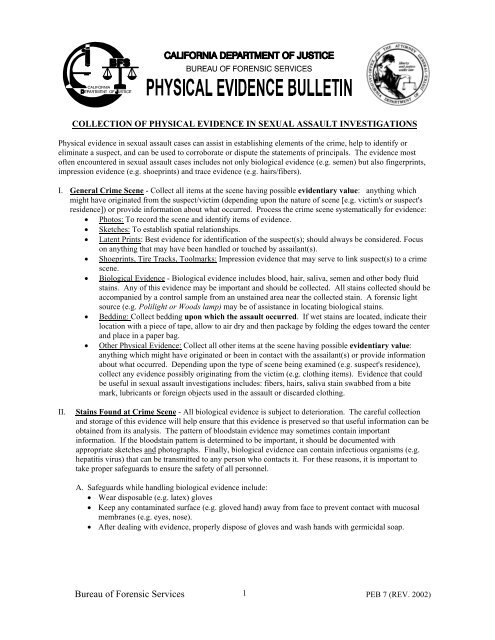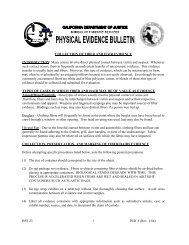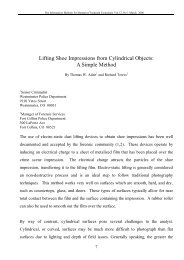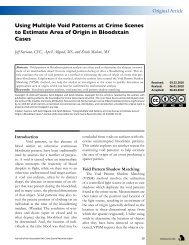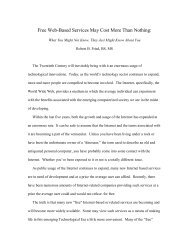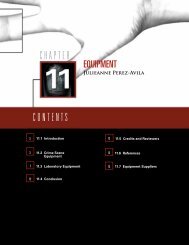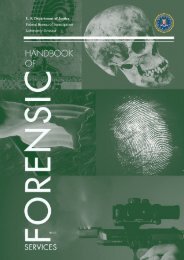Collection of physical evidence in sexual assault - Crime Scene ...
Collection of physical evidence in sexual assault - Crime Scene ...
Collection of physical evidence in sexual assault - Crime Scene ...
You also want an ePaper? Increase the reach of your titles
YUMPU automatically turns print PDFs into web optimized ePapers that Google loves.
COLLECTION OF PHYSICAL EVIDENCE IN SEXUAL ASSAULT INVESTIGATIONS<br />
Physical <strong>evidence</strong> <strong>in</strong> <strong>sexual</strong> <strong>assault</strong> cases can assist <strong>in</strong> establish<strong>in</strong>g elements <strong>of</strong> the crime, help to identify or<br />
elim<strong>in</strong>ate a suspect, and can be used to corroborate or dispute the statements <strong>of</strong> pr<strong>in</strong>cipals. The <strong>evidence</strong> most<br />
<strong>of</strong>ten encountered <strong>in</strong> <strong>sexual</strong> <strong>assault</strong> cases <strong>in</strong>cludes not only biological <strong>evidence</strong> (e.g. semen) but also f<strong>in</strong>gerpr<strong>in</strong>ts,<br />
impression <strong>evidence</strong> (e.g. shoepr<strong>in</strong>ts) and trace <strong>evidence</strong> (e.g. hairs/fibers).<br />
I. General <strong>Crime</strong> <strong>Scene</strong> - Collect all items at the scene hav<strong>in</strong>g possible evidentiary value: anyth<strong>in</strong>g which<br />
might have orig<strong>in</strong>ated from the suspect/victim (depend<strong>in</strong>g upon the nature <strong>of</strong> scene [e.g. victim's or suspect's<br />
residence]) or provide <strong>in</strong>formation about what occurred. Process the crime scene systematically for <strong>evidence</strong>:<br />
• Photos: To record the scene and identify items <strong>of</strong> <strong>evidence</strong>.<br />
• Sketches: To establish spatial relationships.<br />
• Latent Pr<strong>in</strong>ts: Best <strong>evidence</strong> for identification <strong>of</strong> the suspect(s); should always be considered. Focus<br />
on anyth<strong>in</strong>g that may have been handled or touched by assailant(s).<br />
• Shoepr<strong>in</strong>ts, Tire Tracks, Toolmarks: Impression <strong>evidence</strong> that may serve to l<strong>in</strong>k suspect(s) to a crime<br />
scene.<br />
• Biological Evidence - Biological <strong>evidence</strong> <strong>in</strong>cludes blood, hair, saliva, semen and other body fluid<br />
sta<strong>in</strong>s. Any <strong>of</strong> this <strong>evidence</strong> may be important and should be collected. All sta<strong>in</strong>s collected should be<br />
accompanied by a control sample from an unsta<strong>in</strong>ed area near the collected sta<strong>in</strong>. A forensic light<br />
source (e.g. Polilight or Woods lamp) may be <strong>of</strong> assistance <strong>in</strong> locat<strong>in</strong>g biological sta<strong>in</strong>s.<br />
• Bedd<strong>in</strong>g: Collect bedd<strong>in</strong>g upon which the <strong>assault</strong> occurred. If wet sta<strong>in</strong>s are located, <strong>in</strong>dicate their<br />
location with a piece <strong>of</strong> tape, allow to air dry and then package by fold<strong>in</strong>g the edges toward the center<br />
and place <strong>in</strong> a paper bag.<br />
• Other Physical Evidence: Collect all other items at the scene hav<strong>in</strong>g possible evidentiary value:<br />
anyth<strong>in</strong>g which might have orig<strong>in</strong>ated or been <strong>in</strong> contact with the assailant(s) or provide <strong>in</strong>formation<br />
about what occurred. Depend<strong>in</strong>g upon the type <strong>of</strong> scene be<strong>in</strong>g exam<strong>in</strong>ed (e.g. suspect's residence),<br />
collect any <strong>evidence</strong> possibly orig<strong>in</strong>at<strong>in</strong>g from the victim (e.g. cloth<strong>in</strong>g items). Evidence that could<br />
be useful <strong>in</strong> <strong>sexual</strong> <strong>assault</strong> <strong>in</strong>vestigations <strong>in</strong>cludes: fibers, hairs, saliva sta<strong>in</strong> swabbed from a bite<br />
mark, lubricants or foreign objects used <strong>in</strong> the <strong>assault</strong> or discarded cloth<strong>in</strong>g.<br />
II. Sta<strong>in</strong>s Found at <strong>Crime</strong> <strong>Scene</strong> - All biological <strong>evidence</strong> is subject to deterioration. The careful collection<br />
and storage <strong>of</strong> this <strong>evidence</strong> will help ensure that this <strong>evidence</strong> is preserved so that useful <strong>in</strong>formation can be<br />
obta<strong>in</strong>ed from its analysis. The pattern <strong>of</strong> bloodsta<strong>in</strong> <strong>evidence</strong> may sometimes conta<strong>in</strong> important<br />
<strong>in</strong>formation. If the bloodsta<strong>in</strong> pattern is determ<strong>in</strong>ed to be important, it should be documented with<br />
appropriate sketches and photographs. F<strong>in</strong>ally, biological <strong>evidence</strong> can conta<strong>in</strong> <strong>in</strong>fectious organisms (e.g.<br />
hepatitis virus) that can be transmitted to any person who contacts it. For these reasons, it is important to<br />
take proper safeguards to ensure the safety <strong>of</strong> all personnel.<br />
A. Safeguards while handl<strong>in</strong>g biological <strong>evidence</strong> <strong>in</strong>clude:<br />
• Wear disposable (e.g. latex) gloves<br />
• Keep any contam<strong>in</strong>ated surface (e.g. gloved hand) away from face to prevent contact with mucosal<br />
membranes (e.g. eyes, nose).<br />
• After deal<strong>in</strong>g with <strong>evidence</strong>, properly dispose <strong>of</strong> gloves and wash hands with germicidal soap.<br />
Bureau <strong>of</strong> Forensic Services 1<br />
PEB 7 (REV. 2002)
Sta<strong>in</strong>s Found at <strong>Crime</strong> <strong>Scene</strong> (cont'd)<br />
B. Goals <strong>of</strong> Biological Evidence <strong>Collection</strong><br />
• Collect as much sample as possible from a s<strong>in</strong>gle source.<br />
• Keep biological <strong>evidence</strong> sta<strong>in</strong> concentrated.<br />
• Insure that the sample is not <strong>in</strong>advertently mixed with other biological samples (e.g. contam<strong>in</strong>ated)<br />
• Change gloves if they become sta<strong>in</strong>ed with any biological sample.<br />
• Do not talk over any biological <strong>evidence</strong> sample.<br />
• Handle the sample <strong>in</strong> a manner, which m<strong>in</strong>imizes deterioration <strong>of</strong> the sample.<br />
• Air-dry (<strong>in</strong> a stream <strong>of</strong> cool air) the sample as fast as possible.<br />
C. Recommendations for collect<strong>in</strong>g biological <strong>evidence</strong> sta<strong>in</strong>s:<br />
• Handle the <strong>evidence</strong> sta<strong>in</strong>s as little as possible. When possible, submit the item with the sta<strong>in</strong>. This<br />
is the easiest and best method to collect biological <strong>evidence</strong>. If the sta<strong>in</strong> is on a smooth, non-porous<br />
surface and can be easily dislodged, protect if from contact with other objects (e.g. immobilize <strong>in</strong><br />
box).<br />
• If the sta<strong>in</strong> is on a large object with a porous surface (wood or carpet), the area with the sta<strong>in</strong> can be<br />
cut out and packaged <strong>in</strong> paper. Be sure to <strong>in</strong>clude a portion <strong>of</strong> the unsta<strong>in</strong>ed material as a control.<br />
• If it is not possible to collect the object or cut out the sta<strong>in</strong>, the sta<strong>in</strong> may be collected by us<strong>in</strong>g a<br />
slightly moistened (with distilled water) cotton swab. While collect<strong>in</strong>g the sta<strong>in</strong>, an effort should<br />
be made to concentrate it onto a small area on the swab. A control sample <strong>of</strong> an unsta<strong>in</strong>ed area<br />
close to the biological <strong>evidence</strong> sta<strong>in</strong> should also be collected us<strong>in</strong>g the same distilled water and<br />
type <strong>of</strong> swab that was used to collect the <strong>evidence</strong>. Allow the samples to air-dry, then package <strong>in</strong><br />
appropriately marked paper envelopes or folded paper b<strong>in</strong>dles.<br />
• The size <strong>of</strong> the sta<strong>in</strong> should <strong>in</strong>fluence the size <strong>of</strong> a substrate used to collect the sta<strong>in</strong>. Thus, use a<br />
small part <strong>of</strong> a swab or a small piece <strong>of</strong> gauze to collect a small sta<strong>in</strong>. Do not smear a small sta<strong>in</strong><br />
over a large surface.<br />
• To keep the sta<strong>in</strong> concentrated, collect the sta<strong>in</strong> on the smallest area <strong>of</strong> the swab or cotton gauze.<br />
• Small biological <strong>evidence</strong> sta<strong>in</strong>s (e.g. 2 mm size bloodsta<strong>in</strong>) may need special handl<strong>in</strong>g:<br />
Put on a fresh pair <strong>of</strong> gloves before collect<strong>in</strong>g these small sta<strong>in</strong>s.<br />
♦ If the object with the sta<strong>in</strong> can’t be taken, a swab is the best sample collection device.<br />
♦ If these sta<strong>in</strong>s have to be manipulated by a tool, consideration should be given to us<strong>in</strong>g<br />
new, disposable implements (e.g. new razor blade/ disposable pair <strong>of</strong> tweezers).<br />
• Try to m<strong>in</strong>imize the amount <strong>of</strong> time a sta<strong>in</strong> is kept wet. Air-dry all wet sta<strong>in</strong>s as soon as<br />
possible. Do not expose to heat or sunlight <strong>in</strong> an attempt to dry the sta<strong>in</strong>.<br />
Care should be taken to ensure that biological <strong>evidence</strong> is not contam<strong>in</strong>ated dur<strong>in</strong>g its collection:<br />
• To avoid contam<strong>in</strong>ation, do not allow one <strong>evidence</strong> sta<strong>in</strong> to come <strong>in</strong>to contact with other biological<br />
samples. M<strong>in</strong>imize contact with the sample. Do not “talk over” a biological <strong>evidence</strong> sample.<br />
• Each <strong>in</strong>dividual sta<strong>in</strong> should be collected separately. Do not collect or package two separate sta<strong>in</strong>s<br />
together.<br />
• Do not allow <strong>evidence</strong> samples to come <strong>in</strong>to contact with any surface that conta<strong>in</strong>s residue from<br />
another biological sample (e.g. dirty tweezers, bloodsta<strong>in</strong>ed glove, contam<strong>in</strong>ated work surface).<br />
• Use tweezers that have smooth, easy-to-clean work<strong>in</strong>g surfaces.<br />
• Tools (e.g. tweezers, scissors) can be cleaned by thoroughly r<strong>in</strong>s<strong>in</strong>g with a stream <strong>of</strong> distilled water<br />
and dry<strong>in</strong>g thoroughly with paper tissue. Repeat this process twice before us<strong>in</strong>g tool to manipulate<br />
another sample.<br />
Bureau <strong>of</strong> Forensic Services 2<br />
PEB 7 (REV. 2002)
Package all biological <strong>evidence</strong> <strong>in</strong> paper bags or envelopes. Do not use plastic.<br />
• Allow sta<strong>in</strong>s to air dry as much as possible before plac<strong>in</strong>g <strong>in</strong> paper bag or envelope.<br />
• Package the "unsta<strong>in</strong>ed control" separately from the <strong>evidence</strong> sta<strong>in</strong>.<br />
• Package different <strong>evidence</strong> items <strong>in</strong> separate paper conta<strong>in</strong>ers.<br />
• Ensure that paper conta<strong>in</strong>er is large enough to allow air circulation around <strong>evidence</strong> item.<br />
• Clean paper can be placed on (or <strong>in</strong>) a bloodsta<strong>in</strong>ed garment and the garment folded so that the<br />
paper prevents contact between different sta<strong>in</strong>s. Ensure that while items are dry<strong>in</strong>g that the sta<strong>in</strong><br />
patterns are not altered or the sta<strong>in</strong> cross-contam<strong>in</strong>ated with another wet sta<strong>in</strong>.<br />
• Tape seal, <strong>in</strong>itial and date all packages.<br />
II. MEDICAL PERSONNEL<br />
Victim - Refer to the California Medical Protocol for Exam<strong>in</strong>ation <strong>of</strong> Adult Sexual Assault Victims and Child<br />
Sexual Abuse Victims for <strong>evidence</strong> collection guidel<strong>in</strong>es.<br />
♦ Ensure that all cloth<strong>in</strong>g worn dur<strong>in</strong>g or immediately after the <strong>assault</strong> is collected. Package <strong>in</strong><br />
separate paper bags.<br />
III. MEDICAL AND/OR LAW ENFORCEMENT PERSONNEL<br />
Suspect - use a Suspect Sexual Assault Evidence Kit to collect relevant <strong>evidence</strong> and follow kit <strong>in</strong>structions:<br />
1. All Cloth<strong>in</strong>g Worn By Suspect at the time <strong>of</strong> <strong>assault</strong>: Package separately <strong>in</strong> paper bags (not plastic).<br />
2. Pubic Hair Brush<strong>in</strong>g: Place a paper towel or piece <strong>of</strong> paper under the area be<strong>in</strong>g brushed. Brush the<br />
pubic region. Wrap the brush <strong>in</strong> the piece <strong>of</strong> paper and place <strong>in</strong>to a paper envelope. Always collect<br />
pubic hair brush<strong>in</strong>g before collect<strong>in</strong>g pubic hair reference standards.<br />
3. Pubic Hair Reference Standards: Pull or cut close to the sk<strong>in</strong> a m<strong>in</strong>imum <strong>of</strong> 2O-30 hairs from different<br />
areas.<br />
4. Head Hair Reference Standards: Pull or cut close to the sk<strong>in</strong> approximately 20-30 hairs taken from<br />
several areas to <strong>in</strong>clude front, back, sides, and top.<br />
5. Other Body Hairs: Take additional hair samples if case <strong>in</strong>dicates.<br />
6. Blood Samples:<br />
A. Collect a blood sample, approximately 5-7cc, <strong>in</strong> a lavender-stoppered tube [conta<strong>in</strong><strong>in</strong>g EDTA].<br />
The crime laboratory should be <strong>in</strong>formed if the subject had recently received a blood transfusion<br />
<strong>of</strong> any k<strong>in</strong>d. If it is not possible to obta<strong>in</strong> a blood sample, oral (mouth) swabs (e.g. swabs <strong>of</strong> the<br />
<strong>in</strong>side <strong>of</strong> cheek) can <strong>of</strong>ten be used as a reference sample for DNA typ<strong>in</strong>g only. Check with your<br />
local laboratory to determ<strong>in</strong>e the suitability <strong>of</strong> oral (cheek) swabs as reference sample. If oral<br />
samples are obta<strong>in</strong>ed, have the subject r<strong>in</strong>se his mouth with water and then take 2 swabs (one<br />
from the <strong>in</strong>side <strong>of</strong> each cheek). Put on a pair <strong>of</strong> clean gloves and take a sterile swab and<br />
vigorously rotate the swab on the <strong>in</strong>side surface <strong>of</strong> the subject’s cheek. Take another sterile swab<br />
and repeat this process on the other cheek. (Do not use gauze). It is imperative that these<br />
samples be dried as soon as possible <strong>in</strong> a stream <strong>of</strong> cool air. When the samples are dry, they<br />
may be placed <strong>in</strong>to a labeled paper envelope or bag. The <strong>evidence</strong> envelope/bag should be<br />
labeled and taped sealed.<br />
B. Sample for Blood Alcohol or Drug Analysis - Collect 10cc <strong>of</strong> blood <strong>in</strong> a gray-stoppered tube<br />
[conta<strong>in</strong><strong>in</strong>g potassium oxalate/sodium fluoride].<br />
7. Penile Swabs: If <strong>in</strong>dicated by the case history (e.g. if victim was forced to orally or vag<strong>in</strong>ally copulate<br />
assailant) and time frame <strong>of</strong> case, penile swabs may be taken. Us<strong>in</strong>g swabs moistened with distilled<br />
water hold the swabs together as a unit and swab the glands, shaft, and base <strong>of</strong> the penis with a<br />
rotat<strong>in</strong>g motion to ensure uniform sampl<strong>in</strong>g. Air-dry swabs, package, label and seal.<br />
8. Scrotal Swabs: If <strong>in</strong>dicated by the case history (see 8. above/this <strong>evidence</strong> may be especially<br />
important if assailant wore a condom) scrotal swabs may be taken. Us<strong>in</strong>g swabs moistened with<br />
distilled water, hold the swabs together as a unit and swab the scrotum <strong>in</strong> a rotat<strong>in</strong>g motion, focus<strong>in</strong>g<br />
on area <strong>in</strong> closest <strong>in</strong> proximity to penis. Air-dry swabs, package, label and seal.<br />
Bureau <strong>of</strong> Forensic Services 3<br />
PEB 7 (REV. 2002)
9. Extra Swabs - These swabs can be used to collect other semen, blood or saliva sta<strong>in</strong>s on the sk<strong>in</strong>.<br />
Slightly moisten the swabs with distilled water and swab the suspected sta<strong>in</strong>. A control swab should<br />
also be made by swabb<strong>in</strong>g an unsta<strong>in</strong>ed area adjacent to the sta<strong>in</strong>. Label the swabs <strong>in</strong>dicat<strong>in</strong>g the<br />
location from which it was taken. Air dry and package <strong>in</strong> paper carton.<br />
10. Miscellaneous - F<strong>in</strong>gernail scrap<strong>in</strong>gs can be collected us<strong>in</strong>g a toothpick, one toothpick per nail. Place<br />
all five toothpicks from the right hand <strong>in</strong>to appropriate conta<strong>in</strong>er and label. Repeat for left hand.<br />
Collect any other foreign material, place <strong>in</strong> paper b<strong>in</strong>dle and package <strong>in</strong> envelope. Label envelope.<br />
VII. EVIDENCE STORAGE<br />
A. Submit all items to the BFS laboratory <strong>in</strong> your area as soon as possible.<br />
B. If the <strong>evidence</strong> cannot be immediately submitted to the laboratory:<br />
• Refrigerate liquid blood samples. Do not freeze.<br />
• Air-dry all items that conta<strong>in</strong> wet biological <strong>evidence</strong>. Do not subject to heat.<br />
• Until submission to the crime laboratory, freeze all items conta<strong>in</strong><strong>in</strong>g biological <strong>evidence</strong> except<br />
for any metal or glass items (e.g. knives or bottles). Metal or glass items should be stored at<br />
room temperature and submitted to the laboratory as soon as possible.<br />
• Evidence from the scene, suspect and victim must be handled and packaged separately.<br />
Related Physical Evidence Bullet<strong>in</strong>s (PEB):<br />
=> PEB 4 - "<strong>Collection</strong> <strong>of</strong> Evidence Blood and other Body Fluid Sta<strong>in</strong>s and Reference Samples for<br />
Conventional Typ<strong>in</strong>g & DNA Analysis" / PEB 6 - "<strong>Collection</strong> <strong>of</strong> Fiber and Hair Evidence"<br />
=> PEB 17 “Latent Pr<strong>in</strong>t Section”/ PEB23 “Documentation <strong>of</strong> Shoe and Tire Impressions”<br />
=> PEB 22 - "Evidence from Human Bodies"<br />
SUBMIT A COPY OF THE POLICE REPORT TO THE CRIME LABORATORY WITH ANY<br />
EVIDENCE SUBMITTED.<br />
CONTACT YOUR LOCAL BFS CRIMINALISTICS LABORATORY IF YOU HAVE ANY QUESTIONS.<br />
Bureau <strong>of</strong> Forensic Services 4<br />
PEB 7 (REV. 2002)


